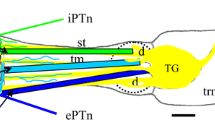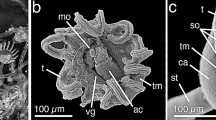Abstract
The upper tentacle of the snail, bearing the olfactory organ, produces complex movements when the snail explores a new environment. Tentacle trajectories were reconstructed in the presence and absence of odors using two simultaneous video recordings. Reconstructions showed that in the absence of odor, snails constantly scanned the surrounding space with the extended tentacles. Presentation of an odor elicited rapid flexion, independent of the odor concentration, accompanied by concentration-dependent tentacle contractions. Activation of identified motoneuron MtC3 is known to elicit tentacle contraction. Recordings made in semi-intact preparations showed that the dynamics and duration of the spike activity of MtC3 produced in response to odors correlated with the degree of tentacle contraction in response to odors. These data suggest that the central motoneuron MtC3, which triggers tentacle contraction, is involved in controlling the margins of the scanning field. Slow contraction or extension of the tentacle, associated with the level of MtC3 activity, may operate to tune the snail's investigative behavior to the conditions of the sensory environment.
Similar content being viewed by others
REFERENCES
P. M. Balaban and I. S. Zakharov, Learning and Development: A Common Basis for Two Phenomena [in Russian], Nauka, Moscow (1992).
I. S. Zakharov, V. N. Mats, and P. M. Balaban, “The role of the giant cerebral neuron in controlling defensive behavior in Helix lucorum,” Neirofiziologiya, 14, No.4, 262–266 (1982).
E. N. Sokolov, Perception and the Conditioned Reflex [in Russian], Moscow State University Press, Moscow (1958).
R. Chase and B. Hall, “Nociceptive inputs to C3, a motoneuron of the tentacle withdrawal reflex in Helix aspersa,” J. Comp. Physiol., A179, 809–818 (1996).
R. Chase and B. Tolloczko, “Tracing neural pathways in snail olfaction: from the top of the tentacles to the brain and beyond,” Microscopy Res. Tech., 24, 214–230 (1993).
B. Dale, “Blood pressure and its hydraulic functions in Helix pomacia L.,” J. Exptl. Biol., 59, No.2, 477–490 (1973).
J. J. Hopfield, “Olfactory computation and object perception,” Proc. Natl. Acad. Sci. USA, 88, 6462–6466 (1991).
J. J. Hopfield, “Odor space and olfactory processing: Collective algorithms and neural implementation,” Proc. Natl. Acad. Sci. USA, 96, 12506–12511 (1999).
J. J. Hopfield and A. Gelperin, “Differential conditioning to a compound stimulus and its components in the terrestrial mollusk Limax maximus,” Behav. Neurosci., 103, 274–293 (1989).
N. Jones, “The nose and paranasal sinuses: physiology and anatomy,” Adv. Drug Delivery Rev., 51, 5–19 (2001).
J. S. Kauer and D. G. Moulton, “Responses of olfactory bulb neurones to odour stimulation of small nasal areas in the salamander,” J. Physiol., 243, 717–737 (1974).
K. Keyhani, P. W. Scherer, and M. M. Mozell, “A numerical model of nasal odorant transport for the analysis of human olfaction,” J. Theor. Biol., 186, 279–301 (1997).
M. Lemaire and R. Chase, “Twitching and quivering of the tentacles during snail olfactory orientation,” J. Comp. Physiol., 182, 81–87 (1997).
P. Mombaerts, “Seven transmembrane proteins as odorant and chemosensory receptors,” Science, 286, No.5440, 707–711 (1999).
E. S. Nikitin and P. M. Balaban, “Optical recording of odor-evoked responses in the olfactory brain of the naive and aversively-trained terrestrial snails,” Learn. Memory, 75, No.6, 422–432 (2000).
S. A. Prescott, N. Gill, and R. Chase, “Neuronal circuit mediating tentacle withdrawal in Helix aspersa, with specific reference to the competence of the motor neuron C3,” J. Neurophysiol., 78, 2951–2965 (1997).
N. J. Vickers, T. A. Christensen, T. C. Baker, and J. G. Hildebrand, “Odour-plume dynamics influence the brain's olfactory code,” Nature, 401, 466–470 (2001).
J. White, S. Mail, and J. S. Kauer, “Using biology to guide development of an artificial olfactory system,” in: Neurotechnology for Biomimetic Robots, MIT Press, Cambridge (2002).
Author information
Authors and Affiliations
Additional information
__________
Translated from Zhurnal Vysshei Nervnoi Deyatel'nosti imeni I. P. Pavlova, Vol. 54, No. 5, pp. 655–665, September–October, 2004.
Rights and permissions
About this article
Cite this article
Nikitin, E.S., Zakharov, I.S. & Balaban, P.M. Regulation of Tentacle Length in Snails by Odor Concentration. Neurosci Behav Physiol 36, 63–72 (2006). https://doi.org/10.1007/s11055-005-0163-5
Received:
Accepted:
Issue Date:
DOI: https://doi.org/10.1007/s11055-005-0163-5




